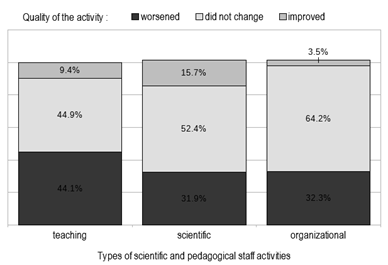INTRODUCTION
In the context of the forced transition to online learning and remote work caused by the COVID-19 pandemic, various aspects of the physiological, psychological and professional well-being of higher education teachers are of particular importance. The restructuring of life and professional rhythms, the situation of uncertainty and the general information saturation have greatly influenced various health disorders of scientific and pedagogical staff. Such changes are characteristic not just for higher education teachers, however, the teaching specifics contribute to a more acute development of the above changes. Lockdown during COVID-19 undoubtedly affected professional activities, but to a greater extent it affected the employees, who continued working during the pandemic, including higher education teachers. The COVID-19 pandemic has led educators to an unpredictable scenario where the lockdown situation has accelerated the transition from traditional teaching methods to the Internet, and relationships have changed by avoiding direct contact with other people, which has significant aftereffects on their health. According to research in Spain, the situation of lockdown has led to serious problems in the personal and professional life of teachers, in particular due to the pressure exerted on them by online educational methods: many hours of work and difficulties due to lack of physical contact or obstacles to reconciling personal life with family. On the other hand, the situation caused by the COVID-19 pandemic has demonstrated the advantages and disadvantages of online learning, as it can help to expand borders and provide education to every house1. The COVID 19 crisis has also exacerbated risk factors, that are usually associated with deteriorating mental health – financial insecurity, unemployment, fear, while protective factors – social ties, employment and education, access to exercise, routine day, access to medical services – fell sharply2. The Health Survey circulated by Kaiser Family Foundation in July 2020 also found that most adults report some negative effects on their mental health and well-being, such as sleep problems (36 %) or eating disorders (32 %), exacerbation of chronic diseases (12 %) due to anxiety and stress caused by coronavirus infection. A large number of people who continue working during a pandemic face a problem that is caused by a higher risk of coronavirus infection compared to those who do not work during lockdown. In contrast to employees whose work is suspended during this period, employees who provide vital communications are more likely to report symptoms of anxiety or depressive disorder (42 % vs. 30 %) during a pandemic3. In present research, we are focused on the professional teachers’ activities. Teachers were found to be concerned about the uncertainty of their professional activity during the COVID-19 pandemic. The rapid transition to online learning has led to a significant increase in the teachers’ workload, as they work not only on the creation and placement of teaching materials on the Internet, but also on the development of skills in using the necessary software. However, for a large number of educational institutions, the transition to the Internet is a significant challenge, as teachers try to adapt to forced working conditions in a relatively short time, while this may be a completely “new normal” phenomenon if it occurs over a long period of time4. Because lockdown during the COVID-19 pandemic affected almost every aspect of society, people had to learn to organize communication and interaction in a new way. In May-June 2020, a study was conducted in Germany that raised the question of how teachers in the quarantine restrictions early stages caused by COVID-19 adapted to teaching via the Internet. Most teachers noted that they updated the curriculum and supplemented it by providing feedback to their students. However, problems that clearly require the integration of information and communication technologies, such as teaching and assessment on the Internet, have been mastered to a lesser extent5. The situation with the COVID-19 pandemic has made significant demands on teachers. In the USA, researches of the teachers’ needs were conducted during the first months of the pandemic. On average, teachers experienced seven stressors (out of 18 suggested in the survey) and four protective factors (out of six suggested in the survey). Teachers who have been exposed to more stressors have reported on deterioration in mental health due to difficulties in teaching and learning. On the other hand, the feeling of more protective factors among the respondents was due to the fact that they do not have difficulties in teaching and learning. The results of the study showed that teachers experienced significant stress as a result of the COVID-19 pandemic, which was associated with deterioration in mental health, coping and learning6. According to the analysis of scientific publications in Ukraine and Russia on the COVID-19 pandemic impact on the higher education sector, it was found that the main issues studied by scientists concerned with the higher education institutions orientation to the distance learning technologies development; the level of educational process participants’ satisfaction with the remote work technologies used in the universities; identifying distance learning opportunities; organization of the educational process by distance learning technologies and its impact on the psyche of students and teachers, etc.7-12. However, along with a wide range of issues related to the educational process organization in higher education institutions in the COVID-19 pandemic context, the deformations problem in various teachers’ health aspects caused by changes in professional activities is not sufficiently covered. The purpose of this study was to identify and analyze teachers’ physiological, psychological and professional changes, which are associated with the educators’ transition to distance learning during quarantine and solving a wide range of professional problems, and which in some way affected various aspects of their health (social, psychological, physical and mental).
METHODS
The following theoretical and empirical research methods were used in the study: theoretical analysis and literature data generalization on the research problem, survey method using the Google Forms cloud service. Statistical methods of survey results analysis included determining the significance of differences in frequency tables and rc-contingency tables using Pearson’s 2 test. When comparing two proportions, the Z-test was used. The Cramer’s V correlation coefficient was used to estimate the relationship between qualitative variables in rc-contingency tables. Hierarchical methods of cluster analysis were used to determine homogeneous groups in the survey data, namely, Ward’s method was used as a linkage rule with (1 % of disagreement) metric, which is most acceptable for clustering qualitative data. When comparing the two clusters by ordinal variables (stressors number, quantity of distance learning advantages/disadvantages, etc.), the Wilcoxon-Mann-Whitney test was calculated. All calculations were made at 95 % confidence level.
RESULTS
The survey of teachers was conducted during January-February 2021 using a questionnaire created by the Google Forms service. The survey was held among research and teaching staff of 42 Ukrainian institutions of higher and professional education. The main part of the questionnaire contained 30 questions, 10 of which concerned with teachers’ physiological changes, 10 – with psychological changes and 10 – with changes in the pedagogical process. 254 teachers took part in the survey, among which 36,6 % there are researchers and teachers aged from 41 to 50 years, 24,8 % – from 31 to 40 years and 21,3 % from 51 to 60 years. The scientific and pedagogical experience of teachers who took part in the survey is from 5 to 20 years (44,5 %) and over 20 years (44,1 %). Thus, we covered an audience of different ages of educators with different teaching experience. This allows us to more objectively analyze the changes that teachers have experienced during online studying. To study the physiological state of health the objects were weight, sleeping, appetite, the presence of headaches, feelings of stress and fatigue, changes in physical activity, work and repose. Respondents’ changes observations in general health, as indicated by the state of nails, hair, skin, and self-care, were studied separately. It was found that in quarantine conditions 50 % of teachers noted appetite disorders (2 = 3,5433, p = 0,0598 > 0,05), and more than half-weight fluctuations (2 = 5,1024, p = 0,0239 < 0,05). The vast majority of respondents (81,1 %) indicated a significant decrease in physical activity (2 = 98,2835, p = 0,0000 < 0,05, Figure 1a). Sleep disorders were detected in more than half of teachers (2 = 4,0315, p = 0,0447 < 0,05), while insomnia and cases of drowsiness were presented in equal proportions (2 = 1,5734, p = 0,2097 > 0,05, Figure 1b).
Analysis of the contingency tables of weight fluctuations with the above factors showed that weight gain was not statistically significantly associated with sleep disorders (2 = 8,899665, p = 0,06366 > 0,05). At the same time, there was a very strong relationship between weight fluctuations and changes in appetite (2 = 70,56832, Cramer’s V = 0,3727, p = 1,721910–14 < 0,05) and a fairly strong correlation between weight gain and changes in physical activity due to quarantine (2 = 22,98413, Cramer’s V = 0,2127, p = 0,00012755 < 0,05). The presence of headache was noted by half of the respondents (2 = 0,7717, p = 0,3797 > 0,05), however the vast majority (2 = 19,2, p < 0,0001) do not associate it with quarantine, but with other reasons, such as large amount of work at the computer during online classes, weather conditions, anxiety, etc. Analysis of survey data on changes in work and repose suggests that only less than 15 % of teachers (Z = 2,1262, p = 0,033483 < 0,05) followed the same distribution of time for work and repose, as before the quarantine restrictions. Among the majority in the same proportions were those who noted a decrease in free time, and those who recognized the loss of the boundary between work and rest (Z = 1,7456, p = 0,0809 > 0,05). The reason for this phenomenon is the necessity to work at home, which blurs the balance of work and repose. The introduction of quarantine restrictions and the transition to online learning significantly affected the leisure of most teachers (2 = 60,5354, p < 0,0001), significantly reducing their time to communicate with family and friends (Z = 3,147046, p = 0,0008246 < 0,05). Thus, working online increases the time a teacher spends working at the computer, which in turn leads to increased stress, fatigue, anxiety, and disruption to work and repose. The obtained data indicates that half of the teachers did not experience changes in general health and well-being (2 = 1,9055, p = 0,1675 > 0,05), but at the same time more than 50 % noted changes in self-care (2 = 6,2992, p = 0,0121 < 0,05). Deterioration of health was recognized by the majority of those who noted changes (Z = 7,3362, p = 1,09910–13 < 0,05), as well as the majority indicated deterioration in self-care (Z = 4,0918, p = 2,140510–5 < 0,05). Our data show a strong direct significant relationship between changes in health and changes in self-care (2 = 53,20654, Cramer’s V = 0,32363, p = 7,714510–11 < 0,05), confirming the conclusion that work online reduces the responsibility for one’s own appearance. The study of teachers’ psychological changes was aimed at self-assessment of emotional state, the emotional stress level and means to seize it, the features of adaptation to changing conditions of professional activity and communication. The survey showed that most respondents rated their emotional state as changeable (2 = 109,6614, p = 0,0000), Figure 2a, declared the feeling of psychological stress by assessing its level as medium (2 = 133,9528, p = 0,0000) (Fig. 2b), a slight increase in anxiety was also observed in most of the interviewed teachers (2 = 33,3622, p < 0,0001).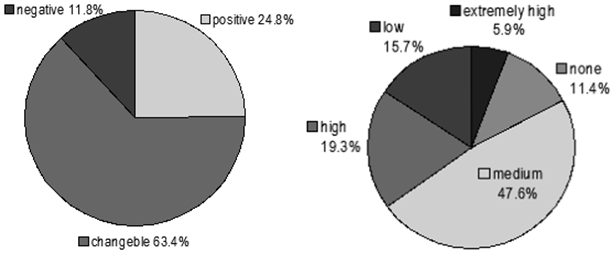
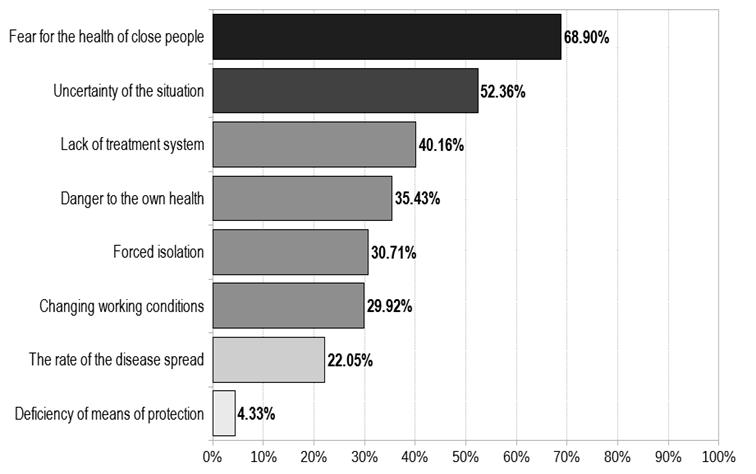
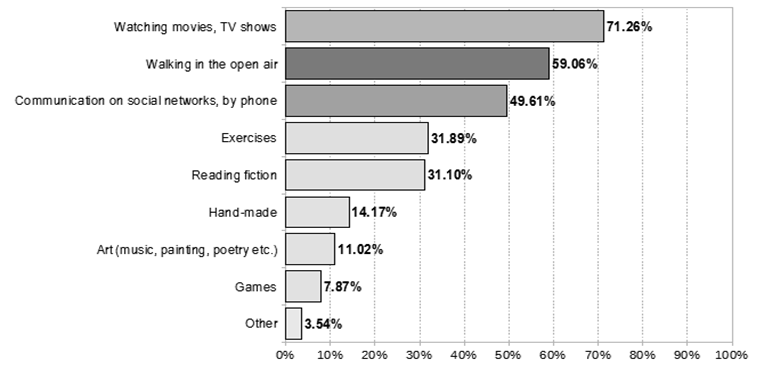
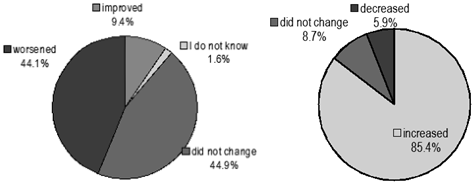
CONCLUSIONS
Present study on the physiological changes and health of research and teaching staff in higher education in Ukraine during the quarantine related to the COVID-19 pandemic showed that online work leads to the deterioration of certain psychosomatic indicators, namely: sleeping disorders, headaches, decreased physical activity, increased anxiety, stress and fatigue, violation of the work-rest regime. Analysis of the survey data on the psychological state of research and teaching staff shows that the situation caused by the pandemic affected their psychological well-being: most of them increased stress, but at the same time, they found various ways to overcome emotional stress. It was also found that the vast majority of respondents managed to adapt to forced changes in the conditions of professional activity, the lack of both personal and professional communication; only a small number of respondents admit that they need qualified psychological help. The study of the impact of the COVID-19 pandemic on professional changes in the pedagogical activities of Ukrainian research and teaching staff of higher education institutions led to the conclusion that educators consider ineffective the use of online learning to achieve learning goals, choosing as an alternative during quarantine, a mixed form of training. Changes in the professional activities of teachers during the distance learning have significantly affected the amount of time allocated to various areas of scientific and pedagogical activities, noting its significant increase in teaching and methodological work, characterized by a large overload of various additional types of work, including the development of distance learning courses, recording of video lectures, preparation and checking assignments, and as a result – lack of free time for repose, which poses a high risk of developing psychological deformations on this basis, and a threat to social and psychological health. Regarding changes in the quality of professional activities, the study showed that in online learning during quarantine, about half of research and teaching staff noted the decline in teaching quality and achievement of educational goals, while the quality of scientific and organizational work of most teachers did not change significantly. The analysis of the research results revealed the division of teachers into two clusters - teachers who coped with professional changes and easily adapted to new teaching conditions (about two thirds of teachers), and teachers who are forced to work in new conditions according to modern requirements, but for whom the experience of transition turned out to be severe and traumatic. The last group consisted of about a third of teachers. It can be assumed that among the causes of such severe consequences are labor intensity, the need to increase the methodological load and intensity in educational work, as well as unwillingness to use information technology.


